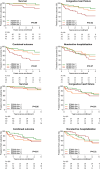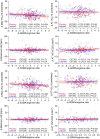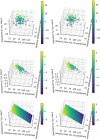Methylated Arginine Metabolites as Biomarkers for Clinical Status and Response to Type 5 Phosphodiesterase Inhibition in Patients With Fontan Circulation
- PMID: 40135558
- PMCID: PMC12132890
- DOI: 10.1161/JAHA.124.038061
Methylated Arginine Metabolites as Biomarkers for Clinical Status and Response to Type 5 Phosphodiesterase Inhibition in Patients With Fontan Circulation
Abstract
Background: There is significant interest in NO pathway modulators, specifically type 5 phosphodiesterase inhibitors (PDE5is), to treat patients with a Fontan circulation. Trials, however, have had mixed results. The relationship between the NO pathway and clinical status in patients with Fontan circulation is a significant knowledge gap.
Methods and results: We performed targeted metabolomic analysis using liquid chromatography coupled to mass spectrometry to quantify plasma NO pathway metabolite concentrations from 2 well-characterized populations of patients with Fontan circulation: the Boston Adult Congenital Heart Disease Biobank and Fontan Udenafil Exercise Longitudinal studies. We investigated associations between NO metabolite concentrations and clinical outcomes, exercise capacity, and response to PDE5is. Increased plasma concentration of asymmetric dimethyl arginine (ADMA), an inhibitor of NO production, was associated with risk for hospitalization or death. Increased ADMA and symmetric dimethyl arginine (another inhibitor of NO production) concentrations were associated with decreased baseline exercise capacity among patients with Fontan circulation with <90% predicted peak oxygen uptake, and change in ADMA and symmetric dimethyl arginine concentrations were predictive of change in exercise capacity over time. Treatment with the PDE5i udenafil uncoupled this association. Finally, baseline ADMA and symmetric dimethyl arginine concentrations predicted response to PDE5is among patients with subnormal peak oxygen uptake.
Conclusions: Plasma concentrations of metabolites that inhibit NO flux are associated with negative clinical outcomes and worse exercise capacity. Moreover, metabolite shifts over time associated with increased NO flux are associated with improved exercise capacity. In patients with a Fontan circulation, the NO pathway modulators ADMA and symmetric dimethyl arginine may be useful as biomarkers of clinical status and predictive of response to PDE5is.
Keywords: Fontan; metabolomics; nitric oxide; type 5 phosophodiesterase inhibitor.
Conflict of interest statement
None.
Figures





References
-
- Rychik J, Atz AM, Celermajer DS, Deal BJ, Gatzoulis MA, Gewillig MH, Hsia TY, Hsu DT, Kovacs AH, McCrindle BW, et al. Evaluation and management of the Child and adult with Fontan Circulation: a Scientific Statement from the American Heart Association. Circulation. 2019;140:E234–E284. doi: 10.1161/CIR.0000000000000696 - DOI - PubMed
MeSH terms
Substances
Grants and funding
LinkOut - more resources
Full Text Sources
Medical
Miscellaneous

